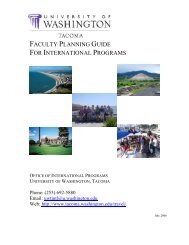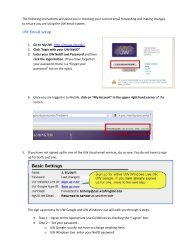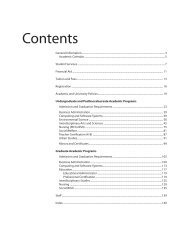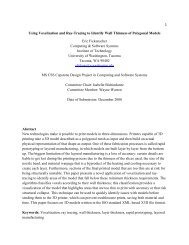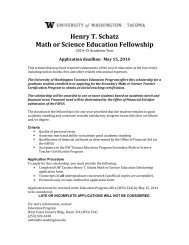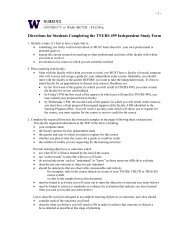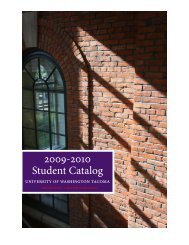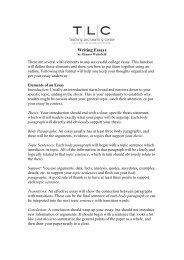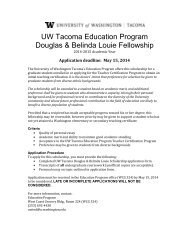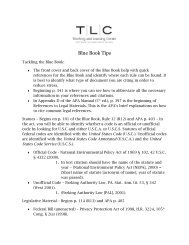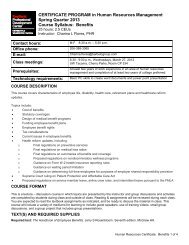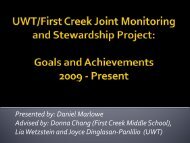Sustainability Plan - University of Washington Tacoma
Sustainability Plan - University of Washington Tacoma
Sustainability Plan - University of Washington Tacoma
You also want an ePaper? Increase the reach of your titles
YUMPU automatically turns print PDFs into web optimized ePapers that Google loves.
<strong>Sustainability</strong>
<strong>Sustainability</strong><br />
Overview<br />
The <strong>University</strong> <strong>of</strong> <strong>Washington</strong> has made a<br />
National Sustainable Design<br />
Standards<br />
• Making the action plan, inventory and<br />
periodic reports publicly available by<br />
very strong commitment to sustainability. This<br />
section <strong>of</strong> the report will address how the UW<br />
<strong>Tacoma</strong> Infrastructure Master <strong>Plan</strong> addresses<br />
those commitments. This section will cover:<br />
• National sustainable design standards that<br />
the UW <strong>Tacoma</strong> has decided to follow<br />
• Campus carbon emissions<br />
American College & <strong>University</strong><br />
Presidents’ Climate Commitment<br />
UW <strong>Tacoma</strong> is a charter member <strong>of</strong><br />
the “American College and <strong>University</strong><br />
Presidents Climate Commitment.”<br />
This commitment requires the<br />
university to develop a “comprehensive plan to<br />
providing them to the Association for the<br />
Advancement <strong>of</strong> <strong>Sustainability</strong> in Higher<br />
Education (AASHE).<br />
One <strong>of</strong> the options proposed in this master plan<br />
<strong>of</strong>fers a potential path to carbon neutrality for the<br />
building heating and electricity component <strong>of</strong> the<br />
campus’ greenhouse gas emissions. Refer to<br />
•<br />
Campus water use<br />
achieve climate neutrality as soon as possible.”<br />
Appendix B for more details on the “American<br />
• Campus energy use and cost<br />
• Campus renewable energy opportunities<br />
• One potential option for a carbon neutral<br />
campus<br />
Some items in this plan include:<br />
• Completing a comprehensive inventory <strong>of</strong><br />
all greenhouse gas emissions (including<br />
emissions from electricity, heating,<br />
commuting, and air travel).<br />
• Establishing a target date for climate<br />
neutrality.<br />
• Requiring all new campus buildings to meet<br />
at least a LEED Silver Standard.<br />
College and <strong>University</strong> Presidents Climate<br />
Commitment.”<br />
USGBC LEED Silver Certification<br />
Virtually all state-funded<br />
projects in <strong>Washington</strong> State<br />
are required to meet the United<br />
States Green Building Council’s<br />
(USGBC) Leadership in Energy<br />
and Environmental Design (LEED) Silver<br />
• Requiring all new appliances and computers<br />
certification requirements. For new construction<br />
to meet Energy Star requirements.<br />
projects, this requires obtaining 33-38 points <strong>of</strong><br />
• Encouraging the use <strong>of</strong> public<br />
the 69 possible LEED points.<br />
Spring 2009<br />
transportation.<br />
• Purchasing or producing at least 15% <strong>of</strong><br />
the institution’s electricity consumption from<br />
renewable sources.<br />
Points can be obtained in the following<br />
categories: sustainable sites, water efficiency,<br />
energy and atmosphere, materials and<br />
24 <strong>University</strong> <strong>of</strong> <strong>Washington</strong> <strong>Tacoma</strong> - Infrastructure Master <strong>Plan</strong>
<strong>Sustainability</strong><br />
resources, indoor environmental quality, and<br />
is a very important step in meeting the overall<br />
<strong>of</strong> the solution to the globalwarming crisis. Their<br />
innovation and design process.<br />
campus goals for energy efficiency and carbon<br />
goal is straightforward: to achieve a dramatic<br />
While the specifics <strong>of</strong> meeting LEED Silver<br />
will be addressed by the design teams <strong>of</strong><br />
individual buildings, the Infrastructure Master<br />
<strong>Plan</strong> recommends following goals regarding site<br />
lighting, water, and energy.<br />
Site Lighting<br />
Site lighting should be designed to meet<br />
Sustainable Sites, Credit #8 - Light Pollution<br />
Reduction. Refer to the lighting section <strong>of</strong> this<br />
report for additional information.<br />
Water Efficiency<br />
Building water use should be 40% less than<br />
the performance requirements <strong>of</strong> EPACT 1992.<br />
Refer to the civil and mechanical portions <strong>of</strong> this<br />
document for additional information.<br />
Energy Efficiency<br />
LEED Silver requires a minimum <strong>of</strong> 14% cost<br />
savings over ASHRAE Standard 90.1. Design<br />
teams are encouraged to exceed this minimum<br />
requirement by at least a factor <strong>of</strong> two. In<br />
addition, the master plan sets specific Energy<br />
Use Index (EUI) goals for each building type.<br />
Meeting these EUI goals for future buildings<br />
neutrality. A list <strong>of</strong> the EUI goals appears later in<br />
this section.<br />
Commissioning<br />
Future building projects should pursue the<br />
“enhanced commissioning “ point in addition<br />
to the LEED pre-requisite for “fundamental<br />
commissioning”<br />
Measurement and Verification (M&V)<br />
Future building projects should pursue the<br />
LEED M&V point in order to help future<br />
design teams predict the infrastructure needs<br />
for the campus and compare them to the goals<br />
indicated in this section <strong>of</strong> the master plan.<br />
Architecture 2030<br />
Architecture 2030, a nonpr<strong>of</strong>it,<br />
nonpartisan and independent<br />
organization, was established<br />
in response to the global<br />
warming crisis by architect<br />
Edward Mazria in 2002. Architecture 2030’s<br />
mission is to rapidly transform the US and<br />
global building sector from a major contributor<br />
<strong>of</strong> greenhouse gas emissions to a central part<br />
reduction in the global warming-causing<br />
greenhouse gas (GHG) emissions <strong>of</strong> the<br />
building sector by changing the way buildings<br />
and developments are planned, designed and<br />
constructed.<br />
Architecture 2030 strives to meet its mission<br />
by galvanizing both the building industry and<br />
the nation to adopt and implement the “2030<br />
Challenge”, a global initiative stating that all new<br />
buildings and major renovations reduce their<br />
fossil fuel GHG-emitting consumption by 50% by<br />
2010, incrementally increasing the reduction for<br />
new buildings to carbon neutral by 2030.<br />
The 2030 Challenge<br />
All new buildings, developments and major<br />
renovations shall be designed to meet a fossil<br />
fuel, GHG-emitting, energy consumption<br />
performance standard <strong>of</strong> 50% <strong>of</strong> the regional<br />
(or country) average for that building type. At a<br />
minimum, an equal amount <strong>of</strong> existing building<br />
area shall be renovated annually to meet a<br />
fossil fuel, GHG-emitting, energy consumption<br />
performance standard <strong>of</strong> 50% <strong>of</strong> the regional (or<br />
country) average for that building type.<br />
Spring 2009<br />
<strong>University</strong> <strong>of</strong> <strong>Washington</strong> <strong>Tacoma</strong> - Infrastructure Master <strong>Plan</strong><br />
25
<strong>Sustainability</strong><br />
The fossil fuel reduction standard for all new<br />
buildings shall be increased to:<br />
60% in 2010<br />
70% in 2015<br />
80% in 2020<br />
90% in 2025<br />
Carbon-neutral in 2030 (using no fossil fuel GHG<br />
emitting energy to operate).<br />
These targets may be accomplished by<br />
implementing innovative sustainable design<br />
strategies, generating on-site renewable power<br />
and/or purchasing (20% maximum) renewable<br />
energy and/or certified renewable energy<br />
credits.<br />
STARS by AASHE<br />
AASHE has recently<br />
introduced the<br />
<strong>Sustainability</strong> Tracking,<br />
Assessment, and Rating System (STARS),<br />
the first comprehensive standard for campus<br />
sustainability. UW <strong>Tacoma</strong> is one <strong>of</strong> over 90<br />
universities involved in the pilot program.<br />
One notable difference between STARS and<br />
other “green” rating systems, is the holistic<br />
approach, which incorporates educational and<br />
economic factors.<br />
The rating system involves both prerequisites<br />
and credits in three categories:<br />
Operations<br />
This category relates most closely to what is<br />
measured by the USGBC’s LEED rating<br />
system for buildings, and these ratings are<br />
applied to all <strong>of</strong> the facilities on campus,<br />
utilities, infrastructure, and grounds. The<br />
operation <strong>of</strong> dining services, recycling and waste<br />
minimization programs, and transportation is<br />
also rated.<br />
Administration and Finance<br />
This category includes the administration and<br />
planning <strong>of</strong> university activities. Points are<br />
awarded based upon socially responsible<br />
investment practices, university relationships<br />
with its partners and the community at-large,<br />
Spring 2009<br />
The Infrastructure Master <strong>Plan</strong> recommends that<br />
all new buildings on campus should be designed<br />
to meet the requirements <strong>of</strong> the Architecture<br />
2030 challenge.<br />
1. Education and Research<br />
2. Operations<br />
3. Administration and Finance<br />
Education and Research<br />
This category explores the investment the<br />
college or university is making to educate<br />
students, faculty, and staff about sustainability<br />
through coursework and extra-curricular<br />
programming. The category also asks for<br />
the amount <strong>of</strong> research and funding in place<br />
to explore new topics and innovations in<br />
sustainability.<br />
and general human resources practices.<br />
Another component deals with the levels <strong>of</strong><br />
diversity, access, and affordability attained<br />
by the university for students and staff. Longrange<br />
strategic planning, as well as specific<br />
plans for the physical development <strong>of</strong> campus,<br />
sustainability, and the mitigation <strong>of</strong> climate<br />
change are included to gauge a university’s<br />
commitment to sustainable practices.<br />
Like LEED, STARS also <strong>of</strong>fers additional<br />
credits for innovative practices.<br />
26 <strong>University</strong> <strong>of</strong> <strong>Washington</strong> <strong>Tacoma</strong> - Infrastructure Master <strong>Plan</strong>
<strong>Sustainability</strong><br />
Greenhouse Gas Emissions<br />
The <strong>University</strong> <strong>of</strong> <strong>Washington</strong> Environmental<br />
Stewardship Advisory Committee has begun<br />
the tracking <strong>of</strong> campus CO 2<br />
equivalent (CO 2<br />
e)<br />
emissions, and the September 2006 to June<br />
2007 annual report includes the following<br />
summary <strong>of</strong> campus emissions. Refer to<br />
Appendix C for standard factors used in these<br />
calculations.<br />
Gross Emissions<br />
(metric tons)*<br />
Emissions Intensity<br />
(kgCO 2<br />
e/capita)<br />
Year 2000 2005 2000 2005<br />
Seattle Campus 221,000 196,000 3,750 3,090<br />
<strong>Tacoma</strong> Campus** 3,130 3,400 1,690 1,380<br />
Bothell Campus 2,450 4,980 1,490 2,660<br />
Outlying Facilities 322 445 2,730 3,480<br />
<strong>University</strong>-wide 226,902 204,825 9,660 10,610<br />
Potential Costs*** $4,000,000 -<br />
$10,000,000<br />
$60,000 -<br />
$150,000<br />
* One metric ton is equivalent to 1.1025 US tons<br />
** For the <strong>Tacoma</strong> campus, approximately 30% <strong>of</strong> the total emissions listed in this table were related to heating and electricity needs in<br />
buildings. The remaining 70% are for commuting, travel, etc.<br />
*** Both a carbon cap and trade system and/or a carbon tax system are currently being discussed regionally, nationally and<br />
internationally. If a carbon tax is implemented, the potential cost could be $20 to $50/metric ton <strong>of</strong> CO 2<br />
emissions. These figures are<br />
based on the Intergovernmental Panel on Climate Change (IPCC) recommendations for a carbon tax to pay for the environmental<br />
effects. The data is from an article entitled “The Power and the Glory” in a special June 21, 2008 issue <strong>of</strong> the magazine “The<br />
Economist”. That issue focused on the future <strong>of</strong> energy.<br />
Figure 2.1 | UW Greenhouse Gas Emissions<br />
Spring 2009<br />
<strong>University</strong> <strong>of</strong> <strong>Washington</strong> <strong>Tacoma</strong> - Infrastructure Master <strong>Plan</strong><br />
27
Campus Water Use<br />
Conserving water is a significant goal <strong>of</strong> this<br />
master plan. Many leaders feel that the next<br />
major environmental challenge after energy is<br />
access to clean water. The access to clean<br />
water is already an issue for about 40% <strong>of</strong> the<br />
world’s population. While the UW <strong>Tacoma</strong><br />
campus currently has access to adequate<br />
quantities <strong>of</strong> clean water, the campus leaders<br />
want to design a campus that conserves this<br />
resource.<br />
Type<br />
Code<br />
(gallons/sf)<br />
Master <strong>Plan</strong> Goal<br />
(gallons/sf)<br />
Reclaim<br />
(gallons/sf)*<br />
Residential 20.0 12.0 7.2<br />
Academic 4.0 2.5 0.5<br />
Academic Science 30.0 15.0 3.8<br />
Library 10.0 6.0 1.8<br />
Student Life 30.0 15.0 9.0<br />
Facilities 10.0 6.0 1.8<br />
Unassigned/Retail 5.5 3.3 0.5<br />
Spring 2009<br />
Ideally, the entire campus would live within its<br />
“natural water budget”. The amount <strong>of</strong> rainfall<br />
that the campus receives over the course <strong>of</strong><br />
a year. <strong>Tacoma</strong> receives approximately 39<br />
inches <strong>of</strong> rainfall annually, and for a campus <strong>of</strong><br />
46 acres, this yields a natural water budget <strong>of</strong><br />
approximately 49 million gallons <strong>of</strong> water per<br />
year.<br />
Currently, the campus uses approximately<br />
5 million gallons <strong>of</strong> water. The master plan<br />
recommends that all future buildings use 40%<br />
less water than the performance requirements<br />
<strong>of</strong> EPACT 1992. If these goals are met, the<br />
campus will use approximately 26 million<br />
gallons at full build out, which is well within<br />
* Amount <strong>of</strong> potable water required if rainwater reclamation and greywater systems are used.<br />
Refer to the civil infrastructure plan for more details.<br />
the “natural water budget”.<br />
If the options presented<br />
in the civil infrastructure<br />
section <strong>of</strong> this document for<br />
stormwater and greywater<br />
reuse are implemented,<br />
then the campus water use<br />
at full build out is reduced<br />
to approximately 15 million<br />
gallons per year.<br />
<strong>of</strong><br />
s<br />
Millions<br />
Gallon<br />
per year<br />
50<br />
40<br />
30<br />
49<br />
26<br />
20 23<br />
10<br />
0<br />
Incoming<br />
Rainfall<br />
5<br />
Current Campus<br />
Domestic Water<br />
Use<br />
Figure 2.2 | Potable Water Use per Square Foot<br />
Full Build Out<br />
Campus Water<br />
Use<br />
15 10<br />
Full Build Out with<br />
Reclaimed Water<br />
Use<br />
Figure 2.3 | Campus Potable Water Use and Rainfall<br />
28 <strong>University</strong> <strong>of</strong> <strong>Washington</strong> <strong>Tacoma</strong> - Infrastructure Master <strong>Plan</strong>
<strong>Sustainability</strong><br />
Campus Drainage Opportunities<br />
Natural means <strong>of</strong> mitigating stormwater run<strong>of</strong>f is<br />
an important practice to be followed in sensitive<br />
environments such as the Thea Foss Waterway<br />
adjacent to the UW <strong>Tacoma</strong> Campus. The<br />
master plan design team worked with UW<br />
<strong>Tacoma</strong> to set natural means <strong>of</strong> mitigating<br />
stormwater as an important goal for the<br />
proposed infrastructure.<br />
The options for stormwater management begin<br />
at the ro<strong>of</strong> level with opportunities for green<br />
ro<strong>of</strong>s on campus. As shown in Figure 2.4, green<br />
ro<strong>of</strong>s are designed to mirror the hydrologic<br />
processes found in nature. Green ro<strong>of</strong>s also<br />
present educational opportunities in monitoring<br />
for their ecological benefits (Figure 2.6). In the<br />
case <strong>of</strong> UW <strong>Tacoma</strong>, the significant downward<br />
slope to the east gives views <strong>of</strong> the lower<br />
building ro<strong>of</strong>s from the up slope buildings. As<br />
an added benefit, green ro<strong>of</strong>s will significantly<br />
improve the aesthetic quality <strong>of</strong> those views<br />
(Figure 2.5).<br />
Figure 2.5 | Green Ro<strong>of</strong> Example (Waterfront Hotel, Vancouver)<br />
Figure 2.4 | Green Ro<strong>of</strong> Hydrologic Processes<br />
Figure 2.6 | Monitoring Schematic, Seattle Green Ro<strong>of</strong> Evaluation Project<br />
Spring 2009<br />
<strong>University</strong> <strong>of</strong> <strong>Washington</strong> <strong>Tacoma</strong> - Infrastructure Master <strong>Plan</strong><br />
29
<strong>Sustainability</strong><br />
At the street level, the stormwater management<br />
system proposed in this master plan includes<br />
permeable pavements, curbless streets and<br />
natural stormwater conveyances which cleanse<br />
the run<strong>of</strong>f as well as express the water at the<br />
surface so that people interact with it as a site<br />
amenity rather than as a nuisance.<br />
Storage elements are also proposed to allow<br />
for the reuse or harvest <strong>of</strong> this resource rather<br />
than allowing it to burden the Thea Foss<br />
Waterway. Daylighting and reusing stormwater<br />
that courses in pipes beneath the streets is also<br />
a unique opportunity for this campus to pursue.<br />
As this water is brought to the surface, energy<br />
dissipation structures calm the water before it is<br />
cleansed.<br />
The reuse <strong>of</strong> upgradient stormwater benefits<br />
the community by reducing and cleansing the<br />
run<strong>of</strong>f before it flows to the sensitive Thea<br />
Foss. This also benefits the campus as this<br />
water is able to be stored and reused in the<br />
proposed stormwater and greywater recycling<br />
system. If potable water treatments are added<br />
to this system, it is possible to serve the entire<br />
campus’ potable water demands with recycled<br />
stormwater and greywater.<br />
Campus Energy Use and Cost<br />
Reducing energy use helps UW <strong>Tacoma</strong> meet<br />
both its environmental goals and its fiscal<br />
responsibility goals.<br />
Currently the UW <strong>Tacoma</strong> campus spends over<br />
$600,000 per year for electricity and natural gas.<br />
While it is very difficult to predict the future costs<br />
<strong>of</strong> these resources, they will most likely increase<br />
significantly faster than the rate <strong>of</strong> inflation.<br />
The master plan design team has taken the<br />
following steps to reduce future energy needs.<br />
These four steps should also apply to each<br />
building project as the campus grows.<br />
Spring 2009<br />
Figure 2.7 | Natural Drainage, Permeable Paving Example<br />
(South Lake Union Discovery Center, Seattle)<br />
Figure 2.8 | Energy Dissipation Example (Cascade Park, Seattle)<br />
1. Analyze the climate for its impact on energy<br />
use.<br />
2. Integrate the Design. Reduce demand for<br />
use through design strategies.<br />
3. Utilize renewable energy sources at both<br />
the building and campus levels.<br />
4. Verify building performance through<br />
commissioning, and a measurement and<br />
verification (M&V) plan.<br />
30 <strong>University</strong> <strong>of</strong> <strong>Washington</strong> <strong>Tacoma</strong> - Infrastructure Master <strong>Plan</strong>
<strong>Sustainability</strong><br />
Step 1: Analyzing the Climate<br />
The <strong>Tacoma</strong> climate has mild, relatively dry<br />
summers and cool, wet winters. The tables<br />
and charts that follow summarize this climate.<br />
Additional climate information can be found in<br />
Appendix D.<br />
Enough rain falls in <strong>Tacoma</strong> that UW <strong>Tacoma</strong><br />
can reuse the the rainfall that lands there. The<br />
solar and wind resources <strong>of</strong> the site can be used<br />
for reducing the energy use in buildings both<br />
passively (daylighting, passive heating, etc.) and<br />
actively (solar water heating, photovoltaics, wind<br />
power, etc).<br />
<strong>Tacoma</strong>, WA<br />
Notes<br />
Latitude 47.15 Long summer and short winter daylight hours<br />
Longitude 122.25<br />
Elevation ~150<br />
Summer Outside Design Temp.<br />
(0.4% data)<br />
86F<br />
Relatively low summer design temperature<br />
Dry Bulb and Mean Coincident Wet<br />
Bulb (F)<br />
66F<br />
Winter Outside Design Temp.<br />
20<br />
(99.6%)<br />
Summer Diurnal Temp Range 23<br />
This value is the difference between the daytime<br />
high temp and the nighttime low temp. A high<br />
diurnal range like this is good for natural ventilation<br />
and night flushing to reduce the building’s summer<br />
AC load.<br />
Cooling Degree days, 65F base 136 Very low<br />
Cooling Degree days, 55F base 1,088 Less than the UW Seattle campus (1,214)<br />
Heating Degree days, 65F base 4,799 Less than the UW Seattle campus (4,468)<br />
Solar Radiation (kbtu/sf/yr) 415 Relatively low<br />
Annual Precipitation 39 degrees Good for rainwater reclamation<br />
Average Wind Speed (mph) 8 Potential for a small amount <strong>of</strong> on-site wind power<br />
Figure 2.9 | <strong>Tacoma</strong> Climate Summary<br />
Spring 2009<br />
<strong>University</strong> <strong>of</strong> <strong>Washington</strong> <strong>Tacoma</strong> - Infrastructure Master <strong>Plan</strong><br />
31
<strong>Sustainability</strong><br />
Step 2: Integrating Design to Reduce<br />
Energy Use<br />
One sustainable energy goal would be for the<br />
campus to live within its “natural solar energy<br />
budget.” Applying this concept to a campus<br />
means that the campus would not use any<br />
more energy, over the course <strong>of</strong> a year, than the<br />
amount <strong>of</strong> energy provided by the sun. This is<br />
illustrated in Figures 2.10 and 2.11.<br />
<strong>Tacoma</strong> receives approximately 435 KBtu/SF/<br />
year in direct solar radiation. If that energy was<br />
converted directly into electricity at the typical<br />
efficiency <strong>of</strong> today’s photovoltaic (PV) panels<br />
(15% after conversion), they would produce<br />
65 KBtu/SF/year <strong>of</strong> electricity. The current<br />
campus buildings Energy Use Index (EUI) is<br />
approximately 112 Kbtu/sf/yr and this master<br />
plan recommends a weighted average EUI <strong>of</strong><br />
approximately 65 kbtu/sf/yr by the time full build<br />
out is reached in 2040.<br />
Btu<br />
/ Sf / Yr<br />
MWH/yr<br />
500<br />
400<br />
300<br />
200<br />
100<br />
0<br />
250,000<br />
200,000<br />
150,000<br />
100,000<br />
435<br />
65<br />
Recommended<br />
Incoming Solar Potential Energy Current Campus 2040 Campus<br />
Radiation Produced by PV Avg EUI Avg EUI<br />
250,000<br />
112<br />
65<br />
Figure 2.10 | Campus Solar Budget in Btu<br />
Spring 2009<br />
50,000<br />
0<br />
37,500<br />
15,000<br />
45,000<br />
Recommended<br />
Incoming Solar Potential Energy Current Campus 2040 Campus<br />
Radiation Produced by PV Energy Use Energy Use<br />
Figure 2.11 | Campus Solar Budget in MWH<br />
32 <strong>University</strong> <strong>of</strong> <strong>Washington</strong> <strong>Tacoma</strong> - Infrastructure Master <strong>Plan</strong>
<strong>Sustainability</strong><br />
Figure 2.12 summarizes current energy use at<br />
UW <strong>Tacoma</strong>.<br />
Type<br />
Average Annual Energy Use<br />
Electricity<br />
9,400,000<br />
kWh<br />
Natural<br />
Gas<br />
19,500,000<br />
kBtu<br />
Total<br />
15,115,000 kWh<br />
(51,600,000 kBtu)<br />
Average Annual Energy Cost ($) $443,000 $195,000 $638,000<br />
Average Annual Energy Cost per Area ($/GSF) $0.98 $0.43 $1.41<br />
Percent <strong>of</strong> Energy Use by Cost 69% 31% 100%<br />
Energy Use Index (kBtu/sf/year) 71 41 112<br />
Notes:<br />
1. Existing campus = 460,000 GSF<br />
2. Based on electric billing data from <strong>Tacoma</strong> Power for 2005-2006<br />
3. Approximately $40,000 in natural gas costs are currently being spent for heating during the summer months.<br />
Electricity and Natural Gas<br />
UW <strong>Tacoma</strong> receives electricity from <strong>Tacoma</strong><br />
Power from a 12.47kV primary metered service<br />
corresponding to a Schedule G (General Service)<br />
billing rate with a 1.8% discount credit for primary<br />
metering and customer owned transformation.<br />
Over the past 15 years, with the exception <strong>of</strong> the<br />
2000-2001 West Coast Energy Crisis, the cost<br />
per kilowatt-hour (kWh) from <strong>Tacoma</strong> Power<br />
has increased approximately 4% annually over<br />
the previous year’s rate. Taking into account all<br />
components <strong>of</strong> the overall billing rate (energy<br />
use, delivery charges, base customer charge,<br />
etc.), UW <strong>Tacoma</strong>’s electricity rate for 2008 was<br />
approximately $0.051 / kWh.<br />
Figure 2.12 | Existing Campus Energy Use and Cost<br />
Projecting a steady annual rate increase <strong>of</strong> either<br />
4% or 6%, Figures 2.13 and 2.14 depict the<br />
overall billing rate that can be expected over the<br />
next 30+ years for electricity and natural gas.<br />
Spring 2009<br />
<strong>University</strong> <strong>of</strong> <strong>Washington</strong> <strong>Tacoma</strong> - Infrastructure Master <strong>Plan</strong><br />
33
<strong>Sustainability</strong><br />
$ per<br />
KWH<br />
$0.35<br />
$0.30<br />
$0.25<br />
$0.20<br />
$0.15<br />
$0.10<br />
$0.05<br />
$0.00<br />
History<br />
Figure 2.13 | Projected Electrical Price Increases<br />
Projections<br />
6% annual<br />
increase<br />
4% increase through<br />
2015, 5% thereafter*<br />
* Projections <strong>of</strong><br />
State <strong>of</strong> <strong>Washington</strong>, ELCCA<br />
1992 2008 2024 2040<br />
6%increase 1.1 1.31 1.65 2.09 2.64 3.33 4.2<br />
Cost <strong>of</strong> Utilities<br />
One component <strong>of</strong> the campus monthly<br />
electricity charge is a low power factor penalty<br />
enforced by <strong>Tacoma</strong> Power, which costs the<br />
<strong>University</strong> approximately $14,000 annually.<br />
Refer to the electrical infrastructure plan for a<br />
detailed discussion regarding power factor.<br />
The cost <strong>of</strong> natural gas is very difficult to<br />
predict. NW Natural, the Natural Gas utility<br />
serving a large part <strong>of</strong> Oregon and Southwest<br />
<strong>Washington</strong>, is applying a 25% rate increase<br />
for the winter <strong>of</strong> 2008/2009. One <strong>of</strong> the options<br />
in the mechanical infrastructure plan greatly<br />
reduces the reliance on any fossil fuels.<br />
$8<br />
$7<br />
$6<br />
History<br />
Projected<br />
6% annual<br />
increase<br />
$5<br />
$ per<br />
Therm<br />
$4<br />
$3<br />
$2<br />
4% annual<br />
increase*<br />
Spring 2009<br />
$1<br />
$0<br />
1992 2008 2024 2040<br />
NOTE: Rates indicated are nominal and assume 3% annual inflation.<br />
Figure 2.14 | Projected Natural Gas Price Increases<br />
* Projections <strong>of</strong><br />
State <strong>of</strong> <strong>Washington</strong>, ELCCA<br />
34 <strong>University</strong> <strong>of</strong> <strong>Washington</strong> <strong>Tacoma</strong> - Infrastructure Master <strong>Plan</strong>
<strong>Sustainability</strong><br />
Energy Use Charts<br />
Reducing the energy use for future buildings<br />
is a very important part <strong>of</strong> meeting the carbon<br />
neutral campus goals. The next series <strong>of</strong> charts<br />
and graphs summarizes the existing campus<br />
heating, cooling and Energy Use Indices for the<br />
various building types on campus and sets goals<br />
for future building energy use.<br />
The charts also indicate the percentage<br />
increases in efficiency the design team set to<br />
reach the master plan goals. Refer to Appendix<br />
E for a more detailed analysis.<br />
Year<br />
% Peak Heating Load<br />
Improvement<br />
% Peak Cooling Load<br />
Improvement<br />
% EUI Improvement<br />
2011 30% 30% 30%<br />
2015 35% 35% 35%<br />
2019 40% 40% 40%<br />
2023 45% 45% 45%<br />
2027 50% 50% 50%<br />
2031 55% 55% 55%<br />
2035 60% 60% 60%<br />
2039 60% 60% 65%<br />
Figure 2.15 | Master <strong>Plan</strong> Building Energy Improvement Goals<br />
2007 2039 % Change<br />
Student FTEs 2,000 10,000 Increase 400%<br />
Campus GSF 460,000 2,370,000 Increase 415%<br />
Heating <strong>Plan</strong>t (BHP) 430 1,430 Increase 233%<br />
Cooling <strong>Plan</strong>t (Tons) 1,100 3,200 Increase 190%<br />
Campus EUI 112 65 Decrease 42%<br />
Figure 2.16 | Campus Growth Projections<br />
Spring 2009<br />
<strong>University</strong> <strong>of</strong> <strong>Washington</strong> <strong>Tacoma</strong> - Infrastructure Master <strong>Plan</strong><br />
35
<strong>Sustainability</strong><br />
Space Type<br />
Peak Heating Load<br />
(Btuh/SF)<br />
Peak Cooling Load<br />
(Tons/KSF)<br />
Existing 2039 Existing 2039<br />
Residential 25 10 1.5 0.6<br />
Academic 30 12 2.2 0.9<br />
Academic Science 80 32 4.7 1.9<br />
Library 30 12 2.0 0.8<br />
Student Life 30 12 1.9 0.8<br />
Facilities 30 12 1.2 0.5<br />
Unassigned/Retail 30 12 2.3 0.9<br />
Not Used 30 12 2.3 0.9<br />
Weighted Average 36 21 2.5 1.4<br />
Figure 2.17 | Peak Heating and Cooling Loads (Existing and Master <strong>Plan</strong> Goals)<br />
Space Type<br />
EUI<br />
(kBtu/SF/year)<br />
Existing 2039<br />
220<br />
200<br />
180<br />
206<br />
Spring 2009<br />
Residential 102 36<br />
Academic 80 28<br />
Academic Science 206 72<br />
Library 86 30<br />
Student Life 90 32<br />
Facilities 104 36<br />
Unassigned/Retail 160 56<br />
Not Used 160 56<br />
Weighted Average 112 65<br />
Figure 2.18 | Building EUI (Existing and Master <strong>Plan</strong> Goals)<br />
EUI<br />
(kBTU<br />
sq ft/year)<br />
160<br />
140<br />
120<br />
100<br />
80<br />
60<br />
40<br />
20<br />
0<br />
113<br />
72<br />
160<br />
88<br />
56<br />
102 104<br />
56 57<br />
36<br />
80 86 90<br />
44 47 50<br />
Science Retail Residential Facilities Academic Library Student Life<br />
Figure 2.19 | Building EUI Goals per Building Type<br />
Typical <strong>of</strong> Existing Constructed in 2022 Constructed in 2040<br />
36<br />
28 30 32<br />
(k<br />
sq f<br />
36 <strong>University</strong> <strong>of</strong> <strong>Washington</strong> <strong>Tacoma</strong> - Infrastructure Master <strong>Plan</strong>
<strong>Sustainability</strong><br />
$12,000,000<br />
$10,000,000<br />
History<br />
Projections<br />
Maintaining Current<br />
Efficiency Levels<br />
$11,893,125<br />
Option 1:<br />
$7,523,651<br />
$8,000,000<br />
$6,000,000<br />
Option 3:<br />
$7,222,294<br />
$4,000,000<br />
Option 2:<br />
$6,174,385<br />
$2,000,000<br />
Today:<br />
$655,792<br />
$0<br />
1992 2000 2008 2016 2024 2032 2040<br />
Figure 2.20 | Campus Projected Energy Costs in 2008 Dollars<br />
Overlaying the actual campus energy costs,<br />
the predicted energy rate increases and the<br />
projected energy uses for the three options<br />
presented in the mechanical section <strong>of</strong> this<br />
report yields the following Total Campus Energy<br />
Cost Projection graph in Figure 2.20.<br />
• Option 1: more efficient future buildings<br />
and a continuation <strong>of</strong> the current distributed<br />
heating and cooling plants.<br />
• Option 2: more efficient future buildings<br />
and a campus wide geothermal condenser<br />
water loop.<br />
Refer to the mechanical infrastructure plan for<br />
detailed descriptions <strong>of</strong> the various options and<br />
life cycle cost analysis.<br />
• Option 3: more efficient future buildings<br />
and a campus central heating and cooling<br />
plant.<br />
Spring 2009<br />
<strong>University</strong> <strong>of</strong> <strong>Washington</strong> <strong>Tacoma</strong> - Infrastructure Master <strong>Plan</strong><br />
37
<strong>Sustainability</strong><br />
Step 3: Utilizing Renewable Energy<br />
Sources<br />
Active Renewable Energy<br />
Solar Thermal<br />
applied to heating water for use in water source<br />
heat pump systems, or domestic water systems.<br />
Spring 2009<br />
The third step towards meeting the campus<br />
carbon neutral goal is to analyze the potential<br />
sources for renewable energy on the campus<br />
and determine which are best included at the<br />
building scale or at the campus scale.<br />
Passive Renewable Energy<br />
Daylighting<br />
Daylighting is best accomplished at the building<br />
scale and the master plan recommends that<br />
75% <strong>of</strong> the spaces in all future buildings be daylit<br />
to the point that electric lighting systems are not<br />
required to be on when the sun is out. One way<br />
to achieve this goal could be to design narrow<br />
building floor plates.<br />
Passive Solar<br />
Heating<br />
Passive solar<br />
heating is also best<br />
accomplished at the<br />
building scale and is<br />
most appropriate for<br />
the future residential<br />
buildings.<br />
Figure 2.21 | Daylit Building<br />
The solar data in shown in Figures 2.10 and<br />
2.11 present the amount <strong>of</strong> energy available<br />
on the UW <strong>Tacoma</strong> campus in the form <strong>of</strong><br />
solar radiation. This is a significant quantity,<br />
surprisingly even during the largely overcast<br />
winter months. A variety <strong>of</strong> technologies for<br />
tapping this resource exist in the marketplace<br />
today, and should be utilized where possible.<br />
Glazed Panel Flat Plate Solar Collectors<br />
Glazed panel flat<br />
plate solar collectors<br />
are rectangular,<br />
flat panels that are<br />
mounted in fixed<br />
arrangements,<br />
Figure 2.22 | Glazed Panels<br />
typically on the ro<strong>of</strong> <strong>of</strong><br />
a building, angled to face south. They consist <strong>of</strong><br />
a dark colored absorber plate mounted behind<br />
a glass cover. Water is heated by circulating<br />
it through tubing attached to the back <strong>of</strong> the<br />
absorber plate. This lower cost technology is<br />
capable <strong>of</strong> heating water to temperatures as<br />
high as 144°F above ambient; however, it is<br />
much more efficient when heating water to lower<br />
temperatures, such as 100°F. Thus, it is best<br />
Evacuated Heat Pipe Solar Collectors<br />
Evacuated<br />
heat pipe solar<br />
collectives are flat,<br />
rectangular arrays<br />
<strong>of</strong> cylindrical glass<br />
tubes that are also<br />
mounted in fixed<br />
Figure 2.23 | Evacuated Pipes<br />
arrangements on<br />
ro<strong>of</strong>tops. Each glass tube contains an element<br />
inside that absorbs the radiation <strong>of</strong> the sun.<br />
The element is charged with a refrigerant which<br />
undergoes a phase change. Heat is then<br />
transferred from the refrigerant to a header pipe<br />
through which water circulates.<br />
This technology is more costly, but much more<br />
efficient, especially on overcast, cold days. It<br />
is capable <strong>of</strong> heating water to temperatures as<br />
high as 300°F above ambient. It is suitable for<br />
space heating systems, but is more efficient<br />
when used in water source heat pump systems<br />
and domestic water systems.<br />
38 <strong>University</strong> <strong>of</strong> <strong>Washington</strong> <strong>Tacoma</strong> - Infrastructure Master <strong>Plan</strong>
<strong>Sustainability</strong><br />
Solar Air Heating Panels<br />
GeoThermal<br />
a “slinky” to maximize the area <strong>of</strong> contact <strong>of</strong> pipe<br />
Solar air heating panels consist <strong>of</strong> a dark,<br />
The relatively constant temperature <strong>of</strong> the earth<br />
and earth. The heat exchangers are grouped<br />
perforated absorber plate with an air duct<br />
provides an opportunity to utilize geothermal<br />
in rows, approximately 15 ft on center. A fairly<br />
attached to the back. Air heated by the absorber<br />
energy for both heating in the winter, and<br />
large site is needed to create adequate capacity.<br />
plate is drawn through the perforations into the<br />
cooling in the summer. The quantity <strong>of</strong> energy<br />
Due the density <strong>of</strong> this campus, this type <strong>of</strong> heat<br />
air duct. These low cost panels are best used<br />
available is virtually unlimited. Several system<br />
exchanger is not appropriate.<br />
for preheating outside air for air handling units.<br />
approaches are commonly applied to tap this<br />
renewable energy source.<br />
Open Loop Geothermal Well<br />
Solar thermal heating technologies are by their<br />
A water well is drilled to draw water directly from<br />
nature not capable <strong>of</strong> contributing significant<br />
Closed Loop, Vertical Bore Heat Exchangers<br />
the ground. This is by far the most efficient<br />
capacity under conditions <strong>of</strong> peak heating<br />
Vertical heat exchangers are created by boring<br />
method <strong>of</strong> exchanging heat with the earth. The<br />
requirements (i.e. cold, windy, overcast days,<br />
small diameter holes (4-6 in.) in the earth. The<br />
groundwater is then passed through a heat<br />
or nights), but they can be used to supplement<br />
bores might be 200 to 300 feet in depth, into<br />
exchanger, typically for the purpose <strong>of</strong> either<br />
other heating options when conditions are<br />
which a U-shaped plastic tube (1 in.) is inserted.<br />
heating or cooling condenser water in a water<br />
more favorable. In this way, they are capable<br />
Water is circulated through the tube, which<br />
source heat pump system. After the energy has<br />
<strong>of</strong> providing substantial amounts <strong>of</strong> energy to a<br />
acts as a very large heat exchanger with the<br />
been exchanged, the well water can either be<br />
system at very low cost.<br />
surrounding earth. The heat exchangers are<br />
returned to the aquifer via an injection well, used<br />
grouped in arrays, approximately 20 ft on center.<br />
directly for non-potable water uses, or treated<br />
Costs<br />
A fairly large site is needed to create adequate<br />
and used as potable water.<br />
The challenges <strong>of</strong> utilizing this low cost,<br />
capacity. Each heat exchanger can be expected<br />
renewable energy resource include relatively<br />
to have a capacity <strong>of</strong> approximately 18,000 Btu/<br />
Costs<br />
high initial costs per unit <strong>of</strong> capacity, and the low<br />
hr.<br />
Geothermal energy is available at all times <strong>of</strong><br />
grade nature <strong>of</strong> the heat produced. Initial cost<br />
impacts can be reduced considerably through<br />
incentives from government and utility programs.<br />
Closed Loop, Horizontal Trench Heat<br />
Exchangers<br />
Horizontal heat exchangers are created by<br />
digging shallow trenches (6 ft). Plastic tubing is<br />
laid into the trench, <strong>of</strong>ten in a spiral pattern (like<br />
the year and maintains a constant efficiency<br />
regardless <strong>of</strong> weather conditions. The<br />
challenges to taking advantage <strong>of</strong> this low cost,<br />
renewable energy include relatively high initial<br />
cost per unit <strong>of</strong> capacity, low grade nature <strong>of</strong><br />
heat produced, and potential regulatory issues<br />
Spring 2009<br />
<strong>University</strong> <strong>of</strong> <strong>Washington</strong> <strong>Tacoma</strong> - Infrastructure Master <strong>Plan</strong><br />
39
<strong>Sustainability</strong><br />
related to permitting <strong>of</strong> the well (open loop only).<br />
There are scale issues with these types <strong>of</strong><br />
Photovoltaics (PV)<br />
A survey <strong>of</strong> existing water wells in the vicinity <strong>of</strong><br />
systems, and the options should be evaluated<br />
Photovoltaic (PV) technology converts solar<br />
the campus revealed one in existence. A well<br />
as the campus moves closer to its 10,000 FTE<br />
energy into usable electrical energy. If PV<br />
located on adjacent property at 2120 South C<br />
goal.<br />
arrays are applied to 50% <strong>of</strong> the ro<strong>of</strong>tops <strong>of</strong><br />
Street was drilled in 1964, and was capable <strong>of</strong><br />
UW <strong>Tacoma</strong>’s existing buildings, they could<br />
delivering 1400 GPM. A well <strong>of</strong> this size would<br />
Bi<strong>of</strong>uel Boilers and/or CHP<br />
generate almost 10% <strong>of</strong> the electricity used by<br />
provide approximately 7 million BTUH <strong>of</strong> heating<br />
<strong>Tacoma</strong> is one <strong>of</strong> the largest<br />
the campus each year. This technology could<br />
and cooling capacity. Refer to the mechanical<br />
suppliers <strong>of</strong> wood pellets in the<br />
also be incorporated into new campus buildings<br />
infrastructure plan for additional information on<br />
Northwest. In addition, one<br />
as they are built, increasing the percentage <strong>of</strong><br />
this system.<br />
<strong>of</strong> the largest manufacturing<br />
PV-generated electricity used by the campus<br />
Methane<br />
facilities for biodiesel is being<br />
Figure 2.24 | Wood Pellets<br />
constructed on the<br />
over time. Refer to the electrical infrastructure<br />
plan for more information about PV.<br />
Methane is produced when organic matter<br />
<strong>Washington</strong> coast. Either <strong>of</strong> these fuels could<br />
decomposes. It has very similar properties to<br />
be used for central boilers or combined heat and<br />
Wind<br />
natural gas and can be used as a fuel for boilers<br />
power (CHP) systems if the cost <strong>of</strong> natural gas<br />
Traditional industrial<br />
or combined heat and power systems.<br />
(or the cost <strong>of</strong> its carbon emissions) becomes<br />
scale wind turbines<br />
prohibitively expensive.<br />
are sited in areas<br />
There are two potential sources <strong>of</strong> methane<br />
with average wind<br />
for this campus. One is a nearby wastewater<br />
One potential<br />
speeds above 20<br />
treatment plant that is currently flaring methane.<br />
manufacturer to consider<br />
MPH. However, in<br />
Unfortunately, it may be too far away from<br />
is Capstone*. They<br />
the last few years, a<br />
the campus to create a cost effective pipeline<br />
make 30KW and 60KW<br />
number <strong>of</strong> building and<br />
to deliver the methane to campus. A second<br />
microturbines that<br />
campus scale wind<br />
potential source is adding an anaerobic digester<br />
produce both heat and<br />
turbines have been<br />
Spring 2009<br />
to the campus that uses both food waste and<br />
human waste as a feedstock.<br />
Figure 2.25 | Microturbine<br />
power and can operate<br />
on biodiesel.<br />
*Names <strong>of</strong> products stated in this document are not listed as<br />
<strong>University</strong> endorsements, and comparable manufacturers<br />
and products should also be considered.<br />
developed for average<br />
wind speeds <strong>of</strong> 8 MPH.<br />
Figure 2.26 | Wind Turbines<br />
40 <strong>University</strong> <strong>of</strong> <strong>Washington</strong> <strong>Tacoma</strong> - Infrastructure Master <strong>Plan</strong>
<strong>Sustainability</strong><br />
The UW <strong>Tacoma</strong> campus has an average wind<br />
speed <strong>of</strong> about 8 MPH. Integrated wind power<br />
should be considered on future building projects<br />
as the campus expands “up the hill”. Refer to<br />
the electrical and lighting infrastructure plans<br />
for additional information regarding wind power<br />
opportunities.<br />
Green Power<br />
The purchase <strong>of</strong> “green power” either from the<br />
local electric utility provider or from a third party<br />
is an option to ensure that whatever power is<br />
not produced on campus is carbon neutral.<br />
Fortunately, the majority <strong>of</strong> <strong>Tacoma</strong> Power’s<br />
existing generating mix is carbon neutral (90%<br />
hydroelectric and 8% nuclear).<br />
<strong>Tacoma</strong> Power is currently considering new<br />
carbon neutral generating sources to meet their<br />
Renewable Portfolio Standards (RPS). This<br />
may create future opportunities on the campus<br />
to team with <strong>Tacoma</strong> Power to develop these<br />
sources.<br />
Step 4: Verifying Building<br />
Performance<br />
The final step in maximizing the efficiency<br />
<strong>of</strong> building energy use on campus is<br />
commissioning the buildings and developing<br />
a measurement and verification plan at the<br />
campus scale.<br />
Since all new buildings will pursue LEED<br />
Silver certification, fundamental commissioning<br />
will be performed. Enhanced commissioning<br />
and the LEED measurement and verification<br />
(M&V) point should also be implemented. This<br />
will allow future design teams on campus to<br />
compare the status <strong>of</strong> the overall campus energy<br />
use to the predictions made in this master plan.<br />
Having this data will greatly assist design<br />
teams in accurately sizing equipment for future<br />
infrastructure needs.<br />
Carbon Neutral Campus Option<br />
One <strong>of</strong> the main goals <strong>of</strong> this master plan is<br />
to <strong>of</strong>fer UW <strong>Tacoma</strong> a “carbon neutral” option<br />
for the buildings portion <strong>of</strong> the campus’ carbon<br />
emissions.<br />
If the following six items are implemented,<br />
UW <strong>Tacoma</strong> has a good chance <strong>of</strong> virtually<br />
eliminating carbon emissions from its operation<br />
<strong>of</strong> buildings by 2040.<br />
1. Have all future buildings meet or beat the<br />
energy use index (EUI) established in this<br />
section.<br />
2. Implement Option 2 as described in the<br />
mechanical infrastructure plan. This option<br />
recommends a campus condenser water<br />
loop with open loop geothermal wells as the<br />
heat source and heat sink for the majority <strong>of</strong><br />
the campus heating and cooling loads.<br />
3. Incorporate renewable energy generation<br />
in future buildings. Refer to the mechanical<br />
and electrical portions <strong>of</strong> this narrative for<br />
the amount required to meet the goals.<br />
A mix <strong>of</strong> solar thermal, PV and wind is<br />
recommended.<br />
Spring 2009<br />
<strong>University</strong> <strong>of</strong> <strong>Washington</strong> <strong>Tacoma</strong> - Infrastructure Master <strong>Plan</strong><br />
41
<strong>Sustainability</strong><br />
4. Purchase green power for<br />
electricity needs not met by<br />
on-campus generation.<br />
80,000<br />
Vision for a Carbon Neutral Campus<br />
5. Use bi<strong>of</strong>uels or additional<br />
geothermal wells for campus<br />
heating needs beyond<br />
those served by the first two<br />
geothermal wells.<br />
6. Remove the natural gas fired<br />
boilers in the existing heating<br />
plants when they reach the<br />
end <strong>of</strong> their useful life and add<br />
“fossil fuel free” heating plants<br />
in their place. (They can be<br />
heated through chiller/heaters<br />
tapped into the campus<br />
condenser water loop or by<br />
using bi<strong>of</strong>uel boilers).<br />
MWH<br />
70,000<br />
60,000<br />
50,000<br />
40,000<br />
30,000<br />
20,000<br />
10,000<br />
0<br />
Grid Power and Natural Gas<br />
Efficiencyi<br />
40% Green<br />
Power<br />
15% Bi<strong>of</strong>uels<br />
2008 2016 2024 2032 2040<br />
5%<br />
Photovoltaic<br />
10% Solar<br />
Thermal<br />
10% Wind<br />
20%<br />
Geothermal<br />
Figure 2.27 | Vision for a Carbon Neutral Campus<br />
Spring 2009<br />
42 <strong>University</strong> <strong>of</strong> <strong>Washington</strong> <strong>Tacoma</strong> - Infrastructure Master <strong>Plan</strong>



